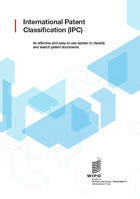尊龙凯时ag体育真人
The 尊龙凯时ag体育真人, established by the Strasbourg Agreement 1971, provides for a hierarchical system of language independent symbols for the classification of patents and utility models according to the different areas of technology to which they pertain. A new version of the IPC enters into force each year on January 1.
Find out more
尊龙凯时官网入口app下载中心
尊龙凯时ag彩票
STATS - A tool which provides IPC predictions based on statistical analysis of the patent documents containing the specified search terms.
IPC Green Inventory - Facilitates searches for patent information relating to Environmentally Sound Technologies.
Training
Upon request,
Also available, training examples prepared by the IPC Revision Working Group and PowerPoint presentations addressing different issues relating to the use of the IPC.
尊龙凯时ag彩票
All master files used to generate the online version of the IPC Classification (and other related files) are freely available for download.
尊龙凯时官网入口最新网址
Regular meetings
- Special Union for the International Patent Classification (IPC Union): Assembly
- Committee of Experts of the IPC Union
- IPC Revision Working Group
Circulars are available in respective meeting pages.
尊龙凯时官网入口官网平台
- IPC Revision Working Group: Fiftieth session (November 20 to 24, 2023)
- Committee of Experts of the IPC Union: Fifty-fourth session (February 22 and 23, 2023)
Related links
尊龙凯时官网入口最新网址
Using PATENTSCOPE, you can search million patent documents including all published international patent applications submitted under the PCT and national and regional collections shared by participating national and regional IP offices.
尊龙凯时ag彩票
WIPO standards
WIPO’s Handbook on Industrial Property Information and Documentation is the authoritative source of the Organization’s standards, recommendations and guidelines in the field of industrial property information and documentation.
尊龙凯时ag官方入口
Find out how artificial intelligence, big data analytics and new technologies such as blockchain can be used to address the growing challenges facing IP offices.
